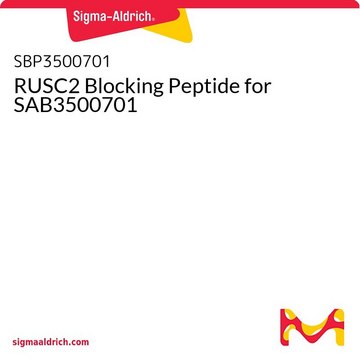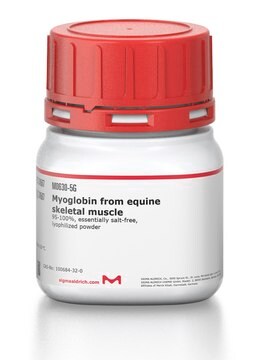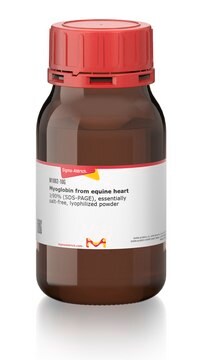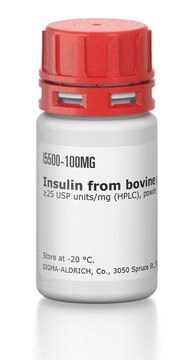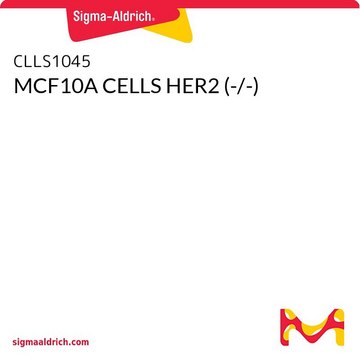CLL1039
MCF10A RFP-TUBA1B
human female mammary glands (Source Disease: Fibrocystic Disease)
Zaloguj sięWyświetlanie cen organizacyjnych i kontraktowych
About This Item
Kod UNSPSC:
41106514
eCl@ss:
32190102
NACRES:
NA.81
Polecane produkty
Nazwa produktu
MCF10A RFP-TUBA1B,
pochodzenie biologiczne
human female mammary glands (Source Disese: Fibrocystic disease)
numer dostępu OMIM
temp. przechowywania
−196°C
informacje o genach
human ... TUBA1B(10376)
Opis ogólny
Ten produkt pochodzi z ATCC Cat. Nr kat. CRL-10317.
MCF10A RFP-TUBA1B to komórki nabłonkowe z chorobą włóknisto-torbielowatą, pochodzące od ludzkiej kobiety (w wieku 36 lat), z modyfikacją znakowaną RFP.
MCF10A RFP-TUBA1B to komórki nabłonkowe z chorobą włóknisto-torbielowatą, pochodzące od ludzkiej kobiety (w wieku 36 lat), z modyfikacją znakowaną RFP.
Tubulina K-α1 / tubulina α 1b (TUBA1B) jest białkiem mikrotubul.Jest to białko o masie ~50 kDa w swojej poliglikozylowanej, potranslacyjnej formie. TUBA1B występuje w komórkach jako jeden z sześciu różnych izotypów. Gen ten znajduje się na ludzkim chromosomie 12q13.12.
Zastosowanie
Aby dowiedzieć się więcej, odwiedź stronę internetową Cellular Reporter Cell Line.
MCF10A RFP-TUBA1B został użyty w testach hodowli komórkowej i analizie western blot.
MCF10A RFP-TUBA1B został wykorzystany do zbadania roli BRCA1 na osi podziału komórkowego.
Produkt ten jest ludzką linią komórkową MCF10A, w której genomowy gen TUBA1B został endogennie wyznakowany genem czerwonego białka fluorescencyjnego (RFP) przy użyciu technologii 4785 Zinc Finger Nuclease. Integracja spowodowała endogenną ekspresję białka fuzyjnego, w którym RFP jest przyłączone do N-końca tubuliny. Obrazowanie fluorescencyjne pokazuje, że tubulina może polimeryzować, tworząc charakterystyczny wzór mikrotubul. Dodanie paklitakselu powoduje oczekiwane wiązanie mikrotubul. Ta stabilna linia komórkowa została rozszerzona z pojedynczego klonu. Regulacja genu docelowego i odpowiadająca mu funkcja białka są zachowane w przeciwieństwie do linii komórkowych z nadekspresją poprzez egzogenny promotor.
Działania biochem./fizjol.
Tubulina K-α1 / tubulina α 1b (TUBA1B) uczestniczy w kilku czynnościach komórkowych, takich jak wiązanie GTP, aktywność GTPazy, utrzymywanie struktury komórkowej w postaci mikrotubul i ruch wewnątrzkomórkowy oparty na mikrotubulach. Odgrywa kluczową rolę w polimeryzacji i depolimeryzacji podczas replikacji i podziału komórek. TUBA1B ulega nadekspresji w tkankach nowotworowych raka wątrobowokomórkowego (HCC) i proliferujących komórkach HCC.
Tubulina α 1b (TUBA1B) jest białkiem mikrotubul, które odgrywa istotną rolę w dynamicznym procesie polimeryzacji i depolimeryzacji podczas replikacji i podziału komórek. TUBA1B ulega nadekspresji w tkankach nowotworowych raka wątrobowokomórkowego (HCC) i proliferujących komórkach HCC. Ta zwiększona ekspresja genu prowadzi do złego rokowania i oporności na chemioterapię w HCC.
Cechy i korzyści
Znakowane RFP na chromosomie 12q13.12.
Komórki MCF10A są przylegające, a czas podwojenia wynosi około 20 godzin.
Komórki MCF10A są przylegające, a czas podwojenia wynosi około 20 godzin.
Komponenty
MCF10A RFP-TUBA1B cells
Jakość
Tested for Mycoplasma, sterility, post-freeze viability, short terminal repeat (STR) analysis for cell line identification, PCR assay for cell line species confirmation.
Uwaga dotycząca przygotowania
Podłoże należy odnawiać dwa do trzech razy w tygodniu.
Fiolkę należy szybko rozmrozić poprzez delikatne mieszanie w łaźni wodnej o temperaturze 37°C (~2 minuty), trzymając korek fiolki z dala od wody. Odkazić 70% etanolem, dodać 9 ml podłoża hodowlanego i odwirować 125 x g (5-7 minut). Ponownie zawiesić w pełnym podłożu hodowlanym i inkubować w temperaturze 37°C w atmosferze 5% CO2.
Stosunek podhodowli: ok. 1:3 do 1:4
Podstawowym podłożem dla tej linii komórek jest Dulbecco's Modified Eagle's Medium/Ham's Nutrient Mixture F-12, nr kat. 51448C. Nr kat. 51448C. Aby uzyskać kompletną pożywkę wzrostową, należy dodać następujące składniki do pożywki podstawowej: surowicę końską, nr kat. Nr kat . H1270, do końcowego stężenia (v/v) 5%; toksynę cholery, Nr kat. Nr kat. C8052, do końcowego stężenia 1 ng/ml, insulina ludzka, Nr kat. I9278, do końcowego stężenia 10 μg/ml, naskórkowy czynnik wzrostu, Nr kat. Nr kat. E9644, do końcowego stężenia 10 ng/ml; oraz hydrokortyzon, Nr kat. H6909, do końcowego stężenia 0,5 μg/ml.
Medium do zamrażania komórek to DMSO 1X(nr kat. C6164).
Fiolkę należy szybko rozmrozić poprzez delikatne mieszanie w łaźni wodnej o temperaturze 37°C (~2 minuty), trzymając korek fiolki z dala od wody. Odkazić 70% etanolem, dodać 9 ml podłoża hodowlanego i odwirować 125 x g (5-7 minut). Ponownie zawiesić w pełnym podłożu hodowlanym i inkubować w temperaturze 37°C w atmosferze 5% CO2.
Stosunek podhodowli: ok. 1:3 do 1:4
Podstawowym podłożem dla tej linii komórek jest Dulbecco's Modified Eagle's Medium/Ham's Nutrient Mixture F-12, nr kat. 51448C. Nr kat. 51448C. Aby uzyskać kompletną pożywkę wzrostową, należy dodać następujące składniki do pożywki podstawowej: surowicę końską, nr kat. Nr kat . H1270, do końcowego stężenia (v/v) 5%; toksynę cholery, Nr kat. Nr kat. C8052, do końcowego stężenia 1 ng/ml, insulina ludzka, Nr kat. I9278, do końcowego stężenia 10 μg/ml, naskórkowy czynnik wzrostu, Nr kat. Nr kat. E9644, do końcowego stężenia 10 ng/ml; oraz hydrokortyzon, Nr kat. H6909, do końcowego stężenia 0,5 μg/ml.
Medium do zamrażania komórek to DMSO 1X(nr kat. C6164).
Informacje prawne
CompoZr is a registered trademark of Merck KGaA, Darmstadt, Germany
Oświadczenie o zrzeczeniu się odpowiedzialności
RESEARCH USE ONLY. This product is regulated in France when intended to be used for scientific purposes, including for import and export activities (Article L 1211-1 paragraph 2 of the Public Health Code). The purchaser (i.e. enduser) is required to obtain an import authorization from the France Ministry of Research referred in the Article L1245-5-1 II. of Public Health Code. By ordering this product, you are confirming that you have obtained the proper import authorization.
Ta strona może zawierać tekst przetłumaczony maszynowo.
Kod klasy składowania
10 - Combustible liquids
Klasa zagrożenia wodnego (WGK)
WGK 3
Temperatura zapłonu (°F)
188.6 °F - closed cup
Temperatura zapłonu (°C)
87 °C - closed cup
Wybierz jedną z najnowszych wersji:
Certyfikaty analizy (CoA)
Lot/Batch Number
Nie widzisz odpowiedniej wersji?
Jeśli potrzebujesz konkretnej wersji, możesz wyszukać konkretny certyfikat według numeru partii lub serii.
Masz już ten produkt?
Dokumenty związane z niedawno zakupionymi produktami zostały zamieszczone w Bibliotece dokumentów.
BRCA1 controls the cell division axis and governs ploidy and phenotype in human mammary cells
He Z, et al.
Oncotarget, 8(20), 32461-32461 (2017)
Zhengcheng He et al.
Oncotarget, 8(20), 32461-32475 (2017-04-22)
BRCA1 deficiency may perturb the differentiation hierarchy present in the normal mammary gland and is associated with the genesis of breast cancers that are genomically unstable and typically display a basal-like transcriptome. Oriented cell division is a mechanism known to
De novo production of K-α1 tubulin-specific antibodies: role in chronic lung allograft rejection.
Goers TA, et al.
Journal of Immunology, 180(7), 4487-4494 (2008)
Increased α-tubulin1b expression indicates poor prognosis and resistance to chemotherapy in hepatocellular carcinoma.
Lu C, et al.
Digestive Diseases and Sciences, 58(9), 2713-2720 (2013)
Up-regulation of TUBA1B promotes astrocyte proliferation after spinal cord injury in adult rats.
Liu Y, et al.
International Journal of Clinical and Experimental Pathology, 10(2), 1094-1103 (2017)
Nasz zespół naukowców ma doświadczenie we wszystkich obszarach badań, w tym w naukach przyrodniczych, materiałoznawstwie, syntezie chemicznej, chromatografii, analityce i wielu innych dziedzinach.
Skontaktuj się z zespołem ds. pomocy technicznej
